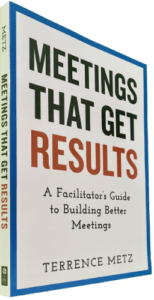To master the art of meeting engagement (i.e., active involvement, collaboration, and participation in meetings), meeting facilitators need a nuanced understanding of various aspects of meeting engagement techniques. To help you achieve this, below we provide you with a Strategic Blueprint for Active Collaboration and Productivity in Every Professional Gathering: a detailed outline focusing on the key elements of meeting engagement, supported by brief comments and links to supporting articles.
I. Meeting Preparation
A. Distribute relevant materials in advance. In invitations for crucial sessions (excluding routine staff meetings), include the following in your meeting invitation:
-
-
-
- Meeting importance, with quantitative support (e.g., cost or labor at risk) if the meeting fails. If the meeting supports a product or project, what is the worth of the product? A poor meeting jeopardizes the product or project, even if only to slow it down.
- Meeting purpose, clarifying why the meeting is essential.
- Meeting scope—scope creep begins in meetings, but you need to determine in advance what we will cover, and more importantly, what we will NOT cover.
- Meeting deliverables, defining success in 50 words or less.
- Simple and draft agenda. Always prepare them with the possibility of minor changes if things develop that would improve or speed up their effort.
-
-
B. Encourage participants to provide in advance their insights or questions so that you can shape your agenda around their input. Their input yields insight into their expectations and becomes the secret for you to manage scope creep.
C. Set expectations for active participation. Explain the Ground Rules “Be Here Now” (professional obligation to speak) and “No Hiding” (applies to virtual or hybrid meetings).
“In for-profit situations, stress duty or fiduciary responsibility. Since participants are professional and being paid to attend, the meeting is not an opportunity for them to contribute. Rather, it is an obligation.”
II. Agenda Design
A. Structure the agenda with a clear insight into the sequence of steps. Include interactive elements such as breakout sessions.
B. Ensure a balance between sharing information and driving behavioral change. If nothing changes, the meeting is a waste of time. The meeting’s value lies in tangible outcomes and actionable insights.
C. Be prepared to explain what DONE looks like with the output from each agenda step, and how it feeds the deliverable to help us get done quicker. Use a metaphor or analogy to explain the rationale behind the sequencing of the agenda steps.
D. Allocate some time for the unexpected and Q&A sessions.
III. Technology Integration
A. Harness collaboration tools, especially in virtual meetings.
B. Regularly employ interactive elements such as breakout sessions and polling to enhance participant involvement and foster dynamic discussions.
C. Guarantee universal access to necessary technology, coupled with a clear understanding of its use, promoting an inclusive and seamless virtual experience.
IV. Visual Aids and Documentation Support
A. Utilize visual aids, legends, and handouts to elevate comprehension and reinforce key concepts.
B. Document input, key points, action items, and open issues in real-time to maintain a dynamic and transparent record.
C. Share meeting notes promptly to solidify engagement and ensure that participants remain informed and aligned.
D. Move beyond the narrative mode; leverage illustrations like the Creativity or Coat of Arms tool. Use Decision Matrices and Quantitative TO-WS analysis for numerical comparisons and insights.
V. Facilitation Technique
A. Integrate icebreakers to establish a positive and open atmosphere, especially in virtual meetings where connection is crucial. Never EVER skip icebreakers in virtual meetings. Remote people are longing for connections.
B. Employ interactive facilitation methods and tools that encourage participation. Always use breakout sessions when in the “Ideation” or “Listing” mode of Brainstorming. Pull the one-team together for the “Analysis” mode and one-voice agreement.
C. Foster a culture of inclusivity and respect for diverse opinions. Explain that no one is smarter than everyone because groups create more options than individuals on their own. Having more options at your disposal remains the number one driver of increasing decision quality. Emphasize that we care about WHAT is right, not WHO is right.
VI. Encourage Active Participation
A. Ask open-ended questions and challenge contributions with probing inquiries like “Because?” or “Why?” to uncover deeper insights. We know that people speak initially about symptoms. Consensus gets built around causal factors, so discover them. We may not agree on whether the “curry” is hot enough or not. We can agree however that it scores 3,000 SHU (Scoville Heat Units) on the capsaicin scale.
B. Always shift air time to your participants. Do not read back to participants. When possible, have each CEO (Chief Easel Officer) perform the read-out for their team. If conducting a readback of some inflection point, appoint a participant. Do not ask them because you are the process police person, the master of context. Always strive to have the reflection of their content come from a participant, not you.
C. Use break-out teams frequently. With three teams you are tripling the available air time.
VII. Follow-up and Accountability
A. Summarize key takeaways and action items at the end of the meeting. Without the documentation trail, nothing happened. Make your action items visual for everyone to see.
B. Facilitate responsibilities and deadlines for providing the team with updates on action items. Consider or modify the RACI approach for clarity.
C. Perhaps suggest or even schedule follow-up sessions to track progress and maintain accountability.
VIII. Feedback Mechanisms
A. Foster an environment where participants feel comfortable sharing diverse opinions, emphasizing the value of multiple perspectives. Stress the likelihood that there is more than one “right answer”. As the facilitator, you are seeking to help them find the best answer for their situation. If there is a clear, right answer—don’t have a meeting.
B. Use their feedback to continuously improve future meetings. Focus feedback on the meeting format and context. What else could you be doing to make their time more effective? Embrace an “inspect and adapt” approach inspired by Agile principles.
C. Exercise caution with praise; focus on praising the team collectively rather than individually. Even positive judgments are a violation of neutrality. If you must praise, compliment the team, not individuals. And always praise the quantity of output that was created, do not evaluate the quality of the output. “You folks got a lot done today.”
D. Acknowledge and appreciate contributions from individual participants privately.
E. If consensus appears evident, celebrate the team’s achievements and milestones.
F. It’s important to be yourself while you foster a positive and collaborative atmosphere. But never forget the importance of maintaining neutrality. All teams need a neutral referee.
By meticulously attending to these aspects, facilitators can cultivate an environment that not only encourages active engagement but also enhances the overall meeting experience, making it more enjoyable, productive, and collaborative.
______
Don’t ruin your career by hosting bad meetings. Sign up for a workshop or send this to someone who should. MGRUSH workshops focus on meeting design and practice. Each person practices tools, methods, and activities daily during the week. Therefore, while some call this immersion, we call it the road to building high-value facilitation skills.
Our workshops also provide a superb way to earn up to 40 SEUs from the Scrum Alliance, 40 CDUs from IIBA, 40 Continuous Learning Points (CLPs) based on Federal Acquisition Certification Continuous Professional Learning Requirements using Training and Education activities, 40 Professional Development Units (PDUs) from SAVE International, as well as 4.0 CEUs for other professions. (See workshop and Reference Manual descriptions for details.)
Want a free 10-minute break timer? Sign up for our once-monthly newsletter HERE and receive a free timer along with four other of our favorite facilitation tools.
Go to the Facilitation Training Store to access proven, in-house resources, including fully annotated agendas, break timers, and templates. Finally, take a few seconds to SHARE this article with others.
To Help You Unlock Your Facilitation Potential: Experience Results-Driven Training for Maximum Impact #facilitationtraining #meeting design
______
No longer a feature in WordPress, we need to append the following to each post for your benefit and reference
- 20 Prioritization Techniques = https://foldingburritos.com/product-prioritization-techniques/
- Creativity Techniques = https://www.mycoted.com/Category:Creativity_Techniques
- Facilitation Training Calendar = https://mgrush.com/public-facilitation-training-calendar/
- Liberating Structures = http://www.liberatingstructures.com/ls-menu
- Management Methods = https://www.valuebasedmanagement.net
- Newseum = https://www.freedomforum.org/todaysfrontpages/
- People Search = https://pudding.cool/2019/05/people-map/
- Project Gutenberg = http://www.gutenberg.org/wiki/Main_Page
- Scrum Events Agendas = https://mgrush.com/blog/scrum-facilitation/
- Speed test = https://www.speedtest.net/result/8715401342
- Teleconference call = https://youtu.be/DYu_bGbZiiQ
- The Size of Space = https://neal.fun/size-of-space/
- Thiagi/ 400 ready-to-use training games = http://thiagi.net/archive/www/games.html
- Visualization methods = http://www.visual-literacy.org/periodic_table/periodic_table.html#
- Walking Gorilla = https://youtu.be/vJG698U2Mvo

Terrence Metz, president of MG RUSH Facilitation Training, was just 22-years-old and working as a Sales Engineer at Honeywell when he recognized a widespread problem—most meetings were ineffective and poorly led, wasting both time and company resources. However, he also observed meetings that worked. What set them apart? A well-prepared leader who structured the session to ensure participants contributed meaningfully and achieved clear outcomes.
Throughout his career, Metz, who earned an MBA from Kellogg (Northwestern University) experienced and also trained in various facilitation techniques. In 2004, he purchased MG RUSH where he shifted his focus toward improving established meeting designs and building a curriculum that would teach others how to lead, facilitate, and structure meetings that drive results. His expertise in training world-class facilitators led to the 2020 publication of Meetings That Get Results: A Guide to Building Better Meetings, a comprehensive resource on effectively building consensus.
Grounded in the principle that “nobody is smarter than everybody,” the book details the why, what, and how of building consensus when making decisions, planning, and solving problems. Along with a Participant’s Guide and supplemental workshops, it supports learning from foundational awareness to professional certification.
Metz’s first book, Change or Die: A Business Process Improvement Manual, tackled the challenges of process optimization. His upcoming book, Catalyst: Facilitating Innovation, focuses on meetings and workshops that don’t simply end when time runs out but conclude with actionable next steps and clear assignments—ensuring progress beyond discussions and ideas.




